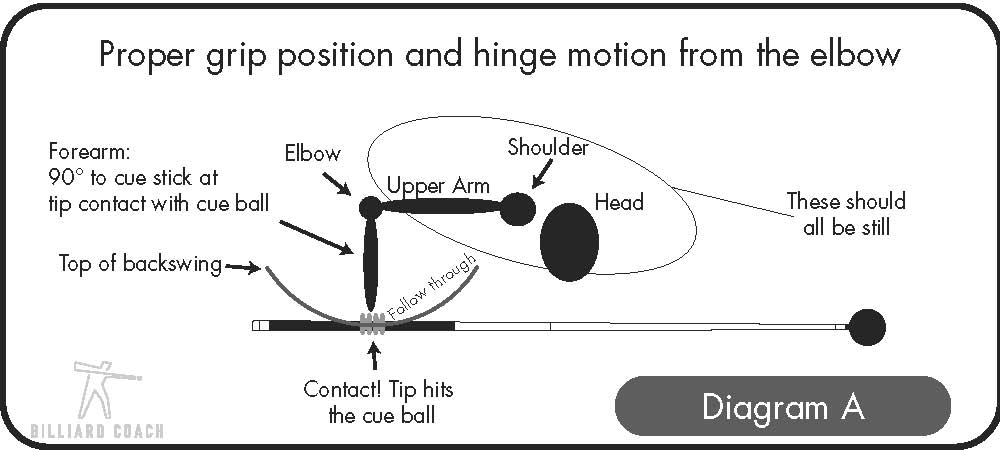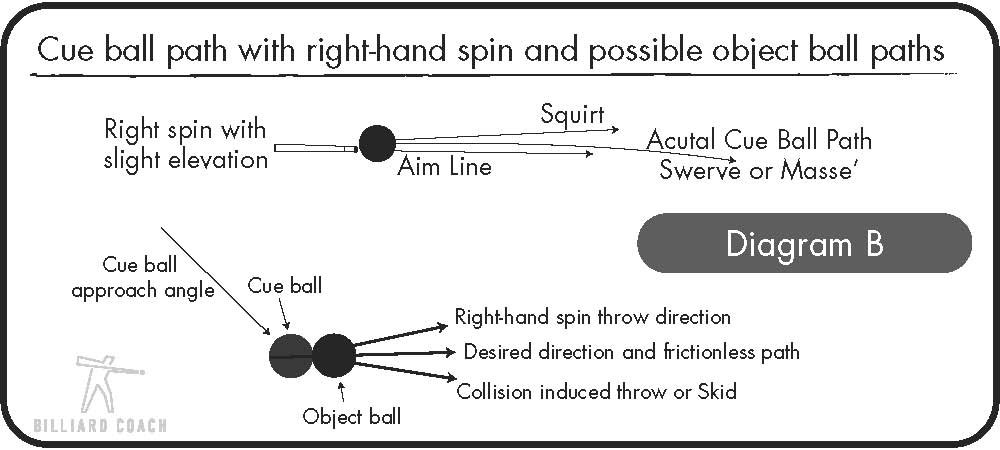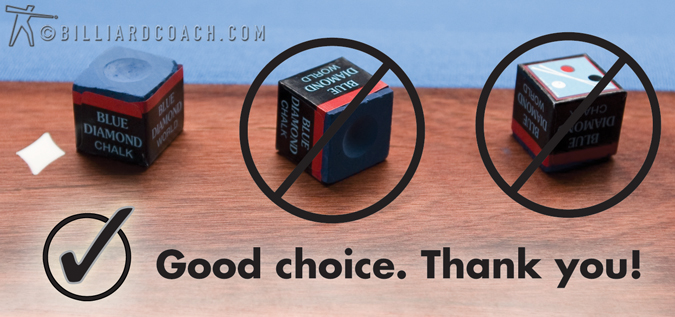© 2009 Mike Fieldhammer, BilliardCoach.com
This month I have three simple reminders to help you look and play better at the table:
1. Be sure your grip hand is not too far back.
2. Do not elevate your cue unless you mean to.
3. Always place the chalk “blue side up.â€
Pool players shorter than 5’10†are far more likely to grip the cue stick too far back. I guess they’ve seen some lanky, run-out player gripping near the bottom of the wrap or several inches up from the rubber bumper. This might be exactly correct for a person who is 6’2â€. . However, your wingspan as a 5’5†pool player is not built to hold it in the same spot. Gripping the cue too far back severely limits your backswing. This robs you of smooth acceleration and power. It also hampers your ability to see the cue moving (hopefully) in a straight line. Furthermore, your back hand can be descending whilst striking the cue ball which increases the possibility of an errant strike.
Cradle the cue in the correct position based on your height and length of the cue stick. Your hand should be hanging straight down from your elbow at the moment the cue tip contacts the cue ball. [See Diagram A] The grip hand should swing smoothly like the pendulum on a grandfather clock. If your hand is positioned properly and your cue stick is level, the game will get much easier to master.

This brings us right to reminder number two. Keep your cue as level to the table surface as possible on every shot. Jump shots and Masse’ shots are obvious exceptions to this rule of thumb. You must realize that on most shots there is still a small degree of elevation. In other words, the cue slopes downward from the back of the cue to the cue tip. The execution of an elevated stroke can cause unwanted curve of the cue ball on its way to the target. [See Diagram B] Aiming is tricky enough without trying to gauge the amount of curve or swerve. Billiard Physicists like Jewett, Shepard, and Alciatore have dissected these effects in the laboratory, but the bottom line is minimize/avoid elevation for a more consistent pool stroke.

Third, my personal crusade for 2009: Please place the cube of chalk on the rail with the blue side up. [See Image C] This game involves a lot of sublime actions/reactions that are affected by friction. Scads of chalk, dirt, and other impurities all change the behavior of the colliding spheres. To play the game well, a player must understand and learn to control cut angle, cue ball deflection, speed, squirt, swerve, throw, skid, and countless varieties of spin. Dirty cloth and balls make these complicated variables even more unpredictable. Preventing the equipment from becoming filthy is something we can all do to help.

In these tough economic times, pool rooms, bars, amusement vendors, and tournament promoters are tempted to cut back on table maintenance and expenses. During the boom times it wasn’t such a big deal to replace worn cloth or throw out a trashed cue ball. Now, it seems tables are going many months longer between getting recovered. Ball cleaners are getting old, not repaired, or used with improper cleaning solutions. Staffing cutbacks prevent suitable cleaning of said equipment.
Players are routinely seeing $1.50 per game or ever increasing table time fees at leagues and tournaments. We have the right to request good equipment and a proper playing environment. We are the customers and those in control of the equipment should listen. We should also be compelled to take care of their equipment.
Exhibit care to make it last and to show the owner’s investment in the expensive equipment is respected and appreciated. This will give you more credibility when you ask for cleaner equipment. Take care of the billiard equipment and everyone can enjoy playing on quality tables with a clean set of balls.
Leave a Reply